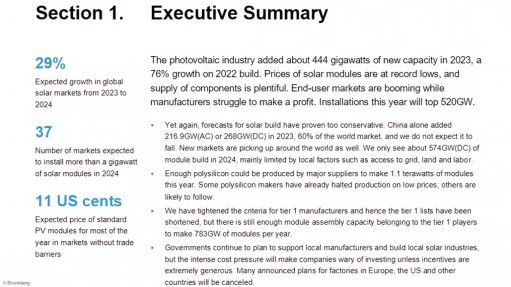
Summary
Photo by: BloombergNEF
BloombergNEF’s (BNEF’s) first-quarter global photovoltaic (PV) market outlook predicts that South Africa will be the tenth-largest PV market in the world this year, with the dominance of solar PV continuing to grow in the country.
“As an industry body, we were proud to have contributed to this globally respected report. The statistics generated by our own solar PV dashboard informed this latest BloombergNEF report and in particular the section that dealt with the South African landscape,” highlights industry body South African Photovoltaic Industry Association (SAPVIA) CEO Dr Rethabile Melamu.
BNEF’s research documents provide a perspective on global commodity markets and the technologies driving the transition to a lower-carbon economy.
According to the report, the PV industry added about 444 GW of new capacity last year internationally, a 76% growth on the 2022 build.
Prices of solar modules are at record lows, and the supply of components is plentiful, SAPVIA avers, adding that end-user markets are booming while manufacturers struggle to make a profit.
Installations are expected to top 520 GW this year.
In South Africa, State-owned utility Eskom estimates that rooftop solar additions totalled 2.6 GW last year, while the BNEF database tracked an additional 676 MW (mostly the 540 MW Scatec Solar Kenhardt plant).
This takes the total for 2023 to about 3.3 GW – slightly below previous estimates.
“Eskom and SAPVIA are also pioneering new methods of estimating rooftop solar capacity in a country, from how observed demand for power on the grid varies with the weather.
“These methods are likely to be used more widely in other countries as incentive programmes for solar become less important and therefore more capacity is built without the need to be registered by a centralised body,” explains BNEF lead solar analyst Jenny Chase, who authored the report.
This year, the report expects rooftop solar to grow, particularly in the winter months of May, June and July when loadshedding is more frequent and severe.
Residential demand for solar is linked directly to loadshedding and slows down as soon as loadshedding stops, SAPVIA points out.
The report also expects business adoption of rooftop solar to accelerate.
According to the information supplied to the report by SAPVIA, 90% to 95% of new residential solar installations and about 85% of commercial ones have battery storage for a few hours.
The pipeline of solar projects registered with national regulator the National Energy Regulator of South Africa since the beginning of 2023 totals 4.3 GW, according to SAPVIA’s own data portal that is available on its website.
BNEF maintains a build forecast for South Africa of 4 GW to 4.5 GW this year, reaching a cumulative capacity of about 36 GW in 2030.